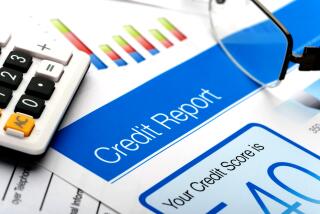Lenders’ data mining goes deep
Reporting from Washington — That pizza you had delivered the other night could mean the difference between whether you are approved for a mortgage or rejected.
There’s a big stretch between making a house payment and paying for a pizza. But it’s not what you pay for carryout that matters, at least not in the eyes of lenders. It’s where the food was delivered.
Ordering takeout proves that you live where you say you do, and that helps lenders uncover the crook who claims to live in the property he is trying to refinance when he really lives hundreds of miles away. Or expose the 35-year-old who says he has a $1,200-a-month apartment when he really lives rent-free with Mom and Dad.
When you order food online, you become part of a vast database that lenders might tap to help them determine whether you are a good risk. Moreover, all sorts of these data reservoirs exist, and none of them is off-limits to lenders who are coming off the worst financial debacle since the Great Depression.
“If the data is available and it can be obtained legally, I’m going to test it,” says Alex Santos, president of Digital Risk, an Orlando, Fla., analytics firm that works with lenders and investors to build better underwriting mousetraps. “If it is inexpensive and makes my credit model better, I’m going to use it.”
Digital Risk is just one of numerous risk-management companies that are continuously probing for ways to help clients quantify their risk, prevent fraud and otherwise ensure the quality of their loans. And they’re going to extraordinary lengths to do so.
For example, they might peek into your online-buying habits. After all, the reasoning goes, someone who buys his shirts from a Brooks Brothers catalog may have more disposable income than someone who shops at JCPenney.
“At least that’s a theory we can test,” Santos says. “We’re looking for any type of data source that you can plug into a computer. It takes only a month of trial and error to determine whether the information can help [determine credit risk] or not. We have a hypothesis, push a button, and the computer tells us whether the data is predictive or not.”
This sort of data mining goes way beyond your credit score, that financial snapshot that measures your ability and willingness to repay your debt. And, Santos says, “there’s a tremendous amount of this kind of analytics going on right now.”
Lenders are still checking credit histories, not just when you apply for a mortgage but also a second time a day or two before the loan closes. But your credit score — known as a FICO score for the name of the company that created the scoring formula — is now considered “too broad.” Consequently, it has moved down in the hierarchy of tests that lenders are using to make certain that someone isn’t hoodwinking them.
First and foremost, lenders are pulling copies of your tax returns directly from Uncle Sam.
Don’t be alarmed. You give the lender permission to do that when you sign Form 4506-T. The idea here is to make sure that you haven’t altered the copy of your last two years’ tax returns that you provided when you signed your loan application. Lenders want to know if you might have exaggerated how much you earned.
Form 4506-T isn’t new. But a few years ago, at the height of the housing-market bonanza when home loans were easy to come by, many lenders failed to use it. Now practically everyone is going straight to the federal tax collector to compare the returns you provided with those on file with the IRS.
Lenders also are going to great lengths to verify employment and assets. Not only are they calling the name and work number you provided on your application, but they also are seeking confirmation in writing from your employer about what you earn, your position and how long you’ve worked there.
It’s the same for your bank accounts. Rather than being satisfied solely with the copies of the bank statements you provided, lenders are going directly to your bank to secure another set of those statements to make sure the numbers line up.
Lenders are no longer taking the appraiser’s word for how much the property you want to buy or refinance is worth, either. Now, they are employing automated valuation models as a second line of defense to be certain the appraiser’s estimate is on the money.
Next in the line of defenses is your credit score, but not just the score pulled when you applied for the loan. Now, they are pulling a second score shortly before closing to make sure that you haven’t taken out a car loan, bought a houseful of furniture on credit or done something else that might change your ability to make your house payments.
Lenders also are searching for other undisclosed liabilities by running your Social Security number through a huge database known as Mortgage Electronic Registration Systems.
Since 1997, more than 63 million mortgages have been registered on the MERS tracking system, each with a distinct 18-digit identification number. So, if you have another mortgage that you “forgot” to tell your lender about, this check will probably find it.
Now, too, the most cautious lenders are digging into noncredit proprietary databases such as those maintained by Papa John’s or Victoria’s Secret. And nothing is out of the realm of possibility. The “only boundary,” says Digital Risk’s Santos, is whether information can be accessed legally.
As long as it does not distinguish between race, religion, age and other “protected” classes, anything is fair game.
Distributed by United Feature Syndicate.
More to Read
Inside the business of entertainment
The Wide Shot brings you news, analysis and insights on everything from streaming wars to production — and what it all means for the future.
You may occasionally receive promotional content from the Los Angeles Times.










